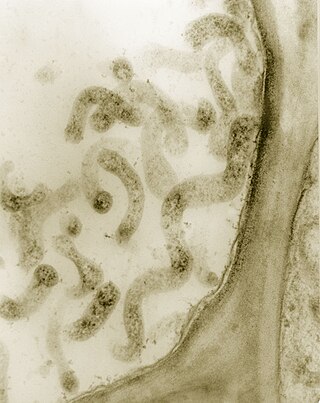
In bacteriology, gram-positive bacteria are bacteria that give a positive result in the Gram stain test, which is traditionally used to quickly classify bacteria into two broad categories according to their type of cell wall.

Gram-negative bacteria are bacteria that do not retain the crystal violet stain used in the Gram staining method of bacterial differentiation. They are characterized by their cell envelopes, which are composed of a thin peptidoglycan cell wall sandwiched between an inner cytoplasmic cell membrane and a bacterial outer membrane.

Pseudomonadota is a major phylum of Gram-negative bacteria. The renaming of several prokaryote phyla in 2021, including Pseudomonadota, remains controversial among microbiologists, many of whom continue to use the earlier name Proteobacteria, of long standing in the literature. The phylum Proteobacteria includes a wide variety of pathogenic genera, such as Escherichia, Salmonella, Vibrio, Yersinia, Legionella, and many others. Others are free-living (non-parasitic) and include many of the bacteria responsible for nitrogen fixation.

Bacilli is a taxonomic class of bacteria that includes two orders, Bacillales and Lactobacillales, which contain several well-known pathogens such as Bacillus anthracis. Bacilli are almost exclusively gram-positive bacteria.
The Aquificota phylum is a diverse collection of bacteria that live in harsh environmental settings. The name Aquificota was given to this phylum based on an early genus identified within this group, Aquifex, which is able to produce water by oxidizing hydrogen. They have been found in springs, pools, and oceans. They are autotrophs, and are the primary carbon fixers in their environments. These bacteria are Gram-negative, non-spore-forming rods. They are true bacteria as opposed to the other inhabitants of extreme environments, the Archaea.

Acidobacteriota is a phylum of Gram-negative bacteria. Its members are physiologically diverse and ubiquitous, especially in soils, but are under-represented in culture.
Chrysiogenaceae is a family of bacteria.

The Burkholderiales are an order of Pseudomonadota. Like all Pseudomonadota, they are Gram-negative. They include several pathogenic bacteria, including species of Burkholderia, Bordetella, and Ralstonia. They also include Oxalobacter and related genera, which are unusual in using oxalic acid as their source of carbon. Other well-studied genera include Alcaligenes, Cupriavidus, Achromobacter, Comamonas, Delftia, Massilia, Duganella, Janthinobacterium, Polynucleobacter, non-pathogenic Paraburkholderia, Caballeronia, Polaromonas, Thiomonas, Collimonas, Hydrogenophaga, Sphaerotilus, Variovorax, Acidovorax, Rubrivivax and Rhodoferax, and Herbaspirillum.
The Thermotogota are a phylum of the domain Bacteria. The phylum Thermotogota is composed of Gram-negative staining, anaerobic, and mostly thermophilic and hyperthermophilic bacteria.

Entomoplasmatales is a small order of mollicute bacteria.

The Bacillaceae are a family of gram-positive, heterotrophic, rod-shaped bacteria that may produce endospores. Motile members of this family are characterized by peritrichous flagella. Some Bacillaceae are aerobic, while others are facultative or strict anaerobes. Most are not pathogenic, but Bacillus species are known to cause disease in humans.
The Sphingobacteriales is an order of environmental bacteria.
Sphingobacteriaceae is a family of environmental bacteria.
Planctomycetales is an order of bacteria.
The Selenomonadales are an order of bacteria within the class Negativicutes; unlike most other members of Bacillota, they are Gram-negative. The phylogeny of this order was initially determined by 16S rRNA comparisons. More recently, molecular markers in the form of conserved signature indels (CSIs) have been found specific for all Selenomonadales species. On the basis of these markers, the Selenomonadales are inclusive of two distinct families, and are no longer the sole order within the Negativicutes. Several CSIs have also been found specific for both families, Sporomusaceae and Selenomonadceae. Samples of bacterial strains within this order have been isolated from the root canals of healthy human teeth.
Chloroflexales is an order of bacteria in the class Chloroflexia. The clade is also known as filamentous anoxygenic phototrophic bacteria (FAP), as the order contains phototrophs that do not produce oxygen. These bacteria are facultative aerobic. They generally use chemotrophy when oxygen is present and switch to light-derived energy when otherwise. Most species are heterotrophs, but a few are capable of photoautotrophy.
The Natranaerobiales are an order of bacteria placed within the class Clostridia. This order contains the thermophilic bacterial species Natranaerobius thermophilus and the related species Natranaerobaculum magadiense.
Phycisphaeraceae is a family of bacteria.
Iodidimonas is a genus of bacteria.
The Ignavibacteriales are an order of obligately anaerobic, non-photosynthetic bacteria that are closely related to the green sulfur bacteria.






